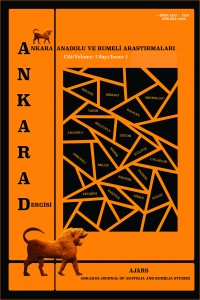Abstract
Hazırlanma sürecinde olan 17. yüzyılda Ankara Gayrimüslimleri isimli Doktora çalışmasından üretilen makalede Ankara’da sakin Ermeni, Rum ve Yahudi tüccarların ticari faaliyetleri ele alınmıştır. Şer’iyye sicillerine dayalı olarak hazırlanan çalışmada Mühimme Defterleri’nde yer alan ilgili kayıtlara da yer verilmiştir. Çalışmanın ana konusu gayrimüslim tüccarlar ve sof ticareti olarak belirlenmiştir. Bu noktada Ankara’da sakin olup ticaretle ilgilenen gayrimüslimlerin yanı sıra çeşitli Avrupa ülkelerinden veya Osmanlı Devleti sınırları içinde bulunan çeşitli şehirlerden ticaret sebebiyle Ankara’ya gelen tüccarlar ele alınmaktadır. Tüccarların çeşitli faaliyetlerinin yanı sıra özellikle sof ticaretindeki rolleri üzerinde durulacaktır. Çalışmanın hazırlanmasındaki amaç Ankara kadı sicillerinde yer alan kayıtlara dayanarak 17. yüzyılda gayrimüslimlerin şehrin sosyoekonomik yapısının oluşumunda üstlendikleri rolü değerlendirmektir. Osmanlı’da önemli bir ticaret merkezi olan Ankara’da Ermeni ve Yahudi tüccarların rolü neydi? Şehrin önemli bir geçim kaynağı olan tiftik ipliği ve sof kumaşı ticaretindeki payları nedir gibi sorulara cevap aranmıştır. Ankaralı gayrimüslimlerin 17. yüzyılda Osmanlı’nın çeşitli yerleri ve Avrupa ülkeleri ile arasında gerçekleşen ticari ilişkilerde hangi ölçüde yer aldıklarının üzerinde durulmuştur. Tüccarların faaliyetlerine dayalı olarak iç ve dış ticarette yalnızca belirli bir bölgede yetişen Tiftik keçisinin kıllarından elde edilen Tiftik ipliği ve bu iplikten üretilen Ankara sofunun uluslararası ticarete konu edilmesindeki payları değerlendirilmiştir. Bu çalışmayla Ankara’nın ticari önemi, gayrimüslim tüccarların şehrin ekonomisine olan katkıları ve sof işçiliğindeki rolleri üzerinde durulacaktır.
Keywords
References
- Eyice Semavi, “Ankara’nın Eski Bir Resmi”, Atatürk Konferansları, Türk Tarih Kurumu Yayınları, c.4, Ankara 1972. ss. 61-123.
- Faroqhi Suraiya, "Onyedinci Yüzyıl Ankara’sında Sof İmalatı ve Sof Atölyeleri," İktisat Fakültesi Mecmuası, c.41/s.14,(tarihsiz), ss. 237-259.
- Faroqhi Suraiya, Osmanlı’da Kentler ve Kentliler, Çev. Neyyir Kalaycıoğlu, Tarih Vakfı Yurt Yayınları, İstanbul 2000.
- Günümüz Türkçesiyle Evliya Çelebi Seyahatnamesi, (Hazırlayanlar: Yücel DAĞLI-Seyit Ali KAHRAMAN), Yapı Kredi Yayınları, c.II, İstanbul 2003.
Abstract
In the article, which was produced from the PhD study named Ankara Non-Muslims in the 17th century, which is in the process of preparation, the commercial activities of the calm Armenian, Greek and Jewish merchants in Ankara were discussed. The current study which is based on the records of Ottoman Court, related records in the Mühimme Register are also included. The main subject of study was determined as non-Muslim traders and sof trade. At this point, besides non Muslims who are interested in trade in Ankara, merchants coming to Ankara due to trade from various European countries or from various cities within the borders of the Ottoman State are discussed. Besides the various activities of the traders, especially their roles in sof trade will be emphasized. The purpose of the study is to evaluate the role of non-Muslims in the formation of the socioeconomic structure of the city of Ankara in the 17th century, based on the records in the Ankara kadi (Court ) records. What was the role of Armenian and Jewish merchants in Ankara, an important trade center in the Ottoman Empire? An answer was sought for questions such as what the role of these merchants was in the trade of mohair goat and sof fabric trade, which was an important source of livelihood of the city. It was especially focused on the role of non-Muslims of Ankara in the commercial relations between various places of the Ottoman Empire and European countries in the 17th century. Based on the activities of the traders, the role of the mohair, which was obtained from the mohair goat and grew only in a certain region in domestic and foreign trade, and the role of Ankara sof, which was made of the mohair, in international trade were evaluated. This study will focus on the commercial importance of Ankara, the contributions of non-Muslim merchants to the city's economy and their roles in sof crafting.
Keywords
References
- Eyice Semavi, “Ankara’nın Eski Bir Resmi”, Atatürk Konferansları, Türk Tarih Kurumu Yayınları, c.4, Ankara 1972. ss. 61-123.
- Faroqhi Suraiya, "Onyedinci Yüzyıl Ankara’sında Sof İmalatı ve Sof Atölyeleri," İktisat Fakültesi Mecmuası, c.41/s.14,(tarihsiz), ss. 237-259.
- Faroqhi Suraiya, Osmanlı’da Kentler ve Kentliler, Çev. Neyyir Kalaycıoğlu, Tarih Vakfı Yurt Yayınları, İstanbul 2000.
- Günümüz Türkçesiyle Evliya Çelebi Seyahatnamesi, (Hazırlayanlar: Yücel DAĞLI-Seyit Ali KAHRAMAN), Yapı Kredi Yayınları, c.II, İstanbul 2003.
Details
| Primary Language | Turkish |
|---|---|
| Journal Section | RESEARCH ARTICLES |
| Authors | |
| Publication Date | July 22, 2020 |
| Submission Date | May 27, 2020 |
| Published in Issue | Year 2020 Volume: 1 Issue: 1 |



